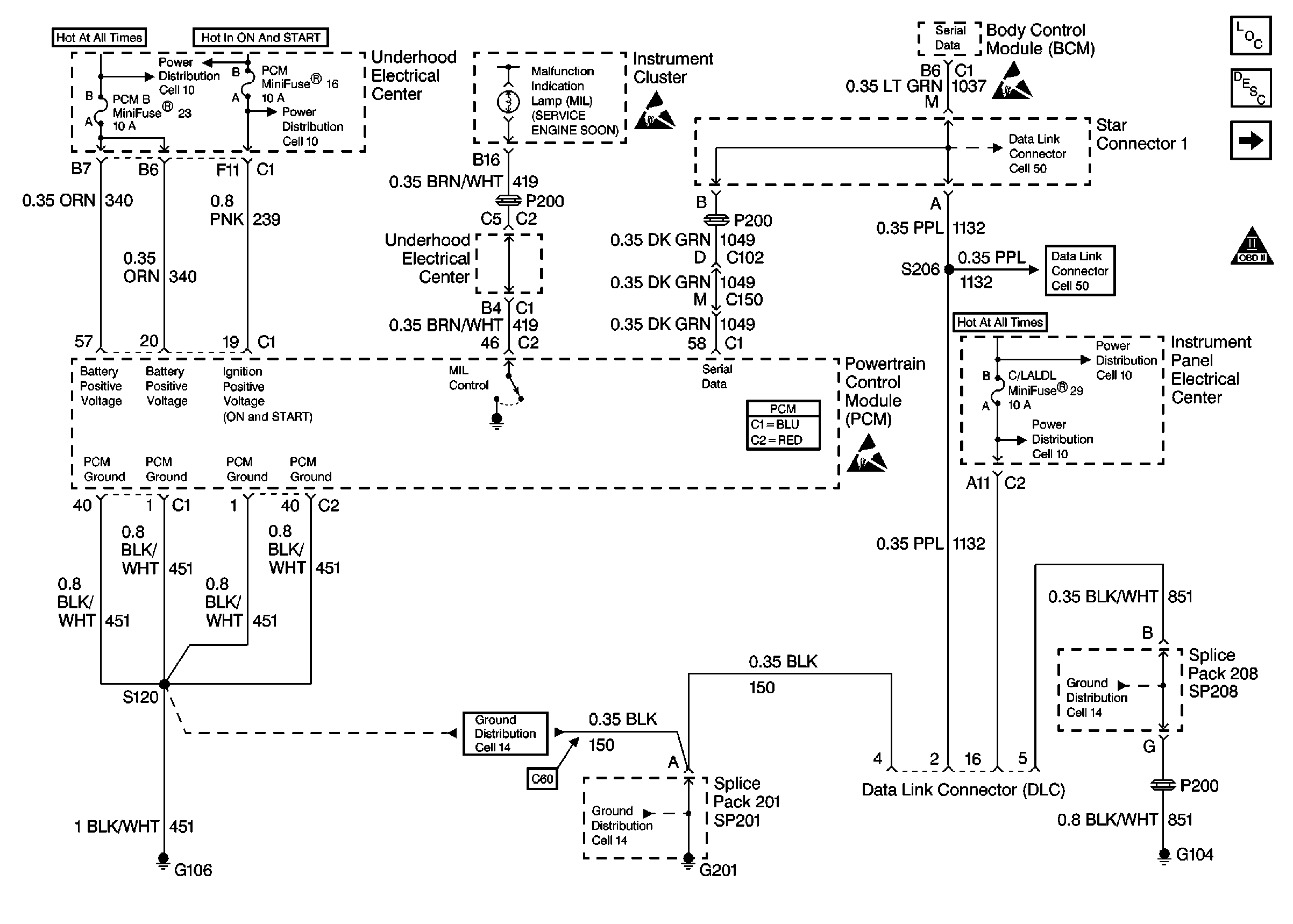Refer to
Cell 20: Power, Ground, DLC and MIL

for complete circuit details.
Description
Use a properly functioning scan tool with the diagnostic tables in this section. DO NOT use the Clear Info function unless instructed by a diagnostic procedure.
Diagnostic Aids
Important:
• Remove any debris from the PCM\TAC module connector surfaces before
servicing the PCM\TAC module. Inspect the PCM\TAC module connector gaskets
when diagnosing/replacing the modules. Ensure that the gaskets are installed
correctly. The gaskets prevent contaminate intrusion into the PCM\TAC
modules. • For any test that requires probing the PCM or a component
harness connector, use the Connector Test Adapter Kit J 35616
. Using this kit prevents damage
to the harness/component terminals. Refer to
Using Connector Test Adapters
in Wiring Systems. • This vehicle, equipped with a Powertrain Control Module (PCM),
utilizes an Electrically Erasable Programmable Read Only Memory (EEPROM).
Program the new PCM when the diagnostics call for replacement of the PCM.
Refer to
Powertrain Control Module/Throttle Actuator Control Module Replacement
. • An engine which starts and then stalls is a good indication that
a concern with the Vehicle Theft Deterrent system, or the Class 2 circuit,
or the Column Lock system exists. Refer to the following areas for
further diagnosis: - Refer to
Diagnostic System Check - Data Link Communications
in Data Link Communications. - Refer to
Diagnostic System Check - Body Control System
in Body Control Systems. - Refer to
Diagnostic System Check - Theft Deterrent
in Theft Deterrent.
Test Description
The numbers below refer to the step numbers on the diagnostic table.
-
An engine which starts and then stalls is a good indication that a concern with the Vehicle Theft Deterrent system, or the Class 2 circuit, or the Column Lock system exists.
-
An engine that just cranks and does not attempt to start indicates that the PCM is not powered-up.
-
A ground must be available at both terminals for the scan tool to operate.
-
A no start condition occurs when fuse 16 or 23 is open. The MIL is inoperative and the Driver Information Center will display the Reduced Engine Power message.
-
If the test lamp does not illuminate for a circuit, inspect the fuse for being open. If the fuse is open, inspect the circuit for a short to ground.
-
Inspect for an open fuse 29 in the Instrument Panel Electrical Center. If the fuse is open, repair the grounded circuit.
Step | Action | Value(s) | Yes | No |
|---|---|---|---|---|
1 | Did you perform the Powertrain On-Board Diagnostic (OBD) System Check? | -- | ||
2 |
Important: This table assumes that the scan tool you are using is functional.
Does the scan tool power-up? | -- | ||
Important: If the engine is not cranked within 5 seconds after the ignition key is turned on, mis-diagnosis could occur. Does the engine start and then stall after approximately 5 seconds? | -- | Go to Diagnostic System Check - Body Control System in Body Control Systems | ||
Did the engine just crank over and not start? | -- | |||
5 |
Is the test lamp illuminated? | -- | ||
Probe the DLC terminals 4 and 5 using the test lamp J 35616-200 connected to B+. Does the test lamp illuminate on both the circuits? | -- | |||
7 | Inspect the scan tool connections to the DLC. Also inspect the terminals for proper terminal tension at the DLC. Refer to Intermittents and Poor Connections Diagnosis in Wiring Systems. Is the action complete? | -- | -- | |
8 | Repair the open ground circuit to the DLC terminals 4 and 5. Refer to Wiring Repairs in Wiring Systems. Is the action complete? | -- | -- | |
Does the test lamp illuminate for each circuit? | -- | |||
10 | Measure the resistance between the battery ground and the PCM ground circuits (C1-1, 40 and C2-1, 40) in the PCM harness connectors using the DMM J 39200 . Does the DMM display the specified value (or lower) on each circuit? | 2ohms | ||
11 |
Did you find and correct the condition? | -- | ||
12 |
Did you find and correct the condition? | -- | ||
13 |
Important: Program the replacement PCM. Refer to Powertrain Control Module/Throttle Actuator Control Module Replacement . Replace the PCM. Is the action complete? | -- | -- | |
Repair the circuit that did not illuminate the test lamp. Refer to Wiring Repairs in Wiring Systems. Is the action complete? | -- | -- | ||
15 | Repair the faulty PCM ground circuit(s). Refer to Wiring Repairs in Wiring Systems. Is the action complete? | -- | -- | |
Repair the faulty B+ supply circuit. Refer to Wiring Repairs in Wiring Systems. Is the action complete? | -- | -- |
